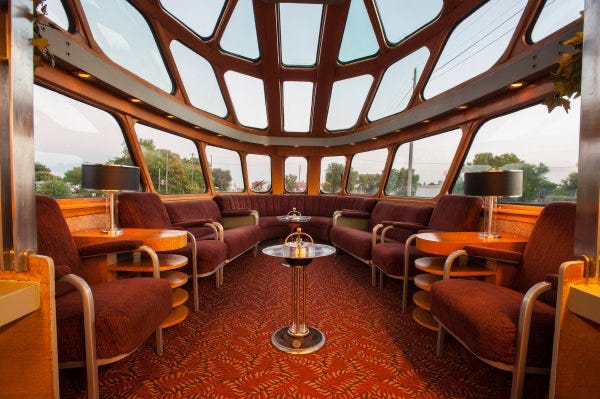Matt Locke | October 29, 2024
The Private Train Car Edition
On hitching your luxury shuttle to an Amtrak, codependency, and industrial barons.
Matt Locke (ML) is a WITI contributor and the Director of Storythings, a content agency based in the UK. His previous WITIs include the Andy Warhol Album Covers Edition and the Platinum Photography Edition.

Matt here. At lunch recently with a friend visiting from the US, he casually mentioned that he’d once traveled on someone’s private rail car through the mountains, from Denver all the way to California. I’d heard of private jets, of course, but never private rail cars. I was curious. How does that even work?
Why is this interesting?
This rabbit hole led me to some of the most spectacular ways to travel I’ve ever seen. The way private rail cars work is a surprising example of luxury capitalism and public infrastructure not just coexisting, but working harmoniously together. In an era when public infrastructure is woefully underfunded, perhaps we can learn something from the history of private rail cars.
The first, burning question I had was: how do you use them to actually travel anywhere? The surprising answer is one of the most maligned names in American public infrastructure: Amtrak. Private rail cars are stored at ordinary train yards, usually at the nearest major hub to their owners’ location. When you want to use them for a trip, you contact Amtrak and arrange for your car to be hitched to the end of a normal scheduled service. So these incredibly luxurious private cars live alongside, and rely on, the ordinary public infrastructure of Amtrak and the US rail network. Without that, they just wouldn’t go anywhere.
The Amtrak guidelines for running your own private rail car are fantastic, with word docs for requesting a move, and guidelines about keeping your car certified to the safety standards needed to use public infrastructure. Although I loved finding the pictures of these beautiful rail cars in my research, I found the Amtrak guidelines page even more joyful. There is something about the generosity of the documentation (like an API for the railroad!), and the mutual co-existence of extreme private luxury and public goods, that really warms my heart.
Private rail cars were, and still are, very much a high-end luxury. The private jets of the late nineteenth and early twentieth century, at their 1929 peak there were about 2,000 in use, owned by industrial barons like Henry Ford and many U.S. Presidents (though Abraham Lincoln apparently hated his so much, it was only ever used to transport his coffin).
These early 20th-century cars cost around $20,000 to build (around $1m in today’s money) and would normally feature an observation deck, sleeping quarters, galleys, and of course a lounge and dining area. They are gorgeous examples of their era’s luxury craftsmanship, full of intricate art deco paneling, brass light fixtures, and gilt detailed bars. The most stunning features were saved for the observation decks, built as a second floor area with glass roof windows, or as a glass conservatory at the end of the carriage. Many private rail cars were made by the Pullman company in Chicago, a name that has become a byword for decadent rail travel.
The observation decks showcased the stunning American countryside and towns, like a widescreen movie rushing past your eyes. Some decks had rotating chairs so you could shift your view between the landscape and your fellow travelers without having to move from your seat. They were a rare example of a luxury private space that didn’t cut you off from the world, but immersed you in it.
Private rail cars reached their height in the early 20th century, before they were pretty much wiped out as a business by the Wall Street Crash. By the time industry barons returned their fortunes to a level where they could again afford private travel, the plane had taken over from the train as the best way to cross the US. But since then, new generations of rich enthusiasts have taken on the work of restoring these masterpieces to their former glory, and you can now buy tickets on scheduled trips or charter a private rail car for your own event.
The super rich of today seem only to dream of ways of cutting themselves off from the messy reality of wider society in self driving cars, metaverses and hyperloops. Back at the turn of the nineteenth century, the 1% could have all the privacy and splendor their riches could afford them, but they still had to rely on public networks, hitching themselves to regular scheduled services full of the workers who made their fortunes for them; on rails maintained through a mixture of investment through private freight services and federal subsidies.
There is something about this coexistence and codependency of the public and the private which feels even more important now than it was in our last Gilded Age. (ML)
Quick Links
The American Association of Private Rail Car Owners has lots of details about how to own, or charter, a private rail car, and links to their members’ cars. They also run autumn leaves journeys, running a collection of private cars together through the beautiful fall scenery of the US.
This is a fantastic video from DownieLive of his trip on an autumn leaves train as it went to its pick up destination, showing the incredible beauty of the cars and the landscape rushing past.
Friends of the 261 is a non-profit organization that restores and runs trips on private rail cars, including the Cedar Rapids pictured above. I also love their minimalist URL.